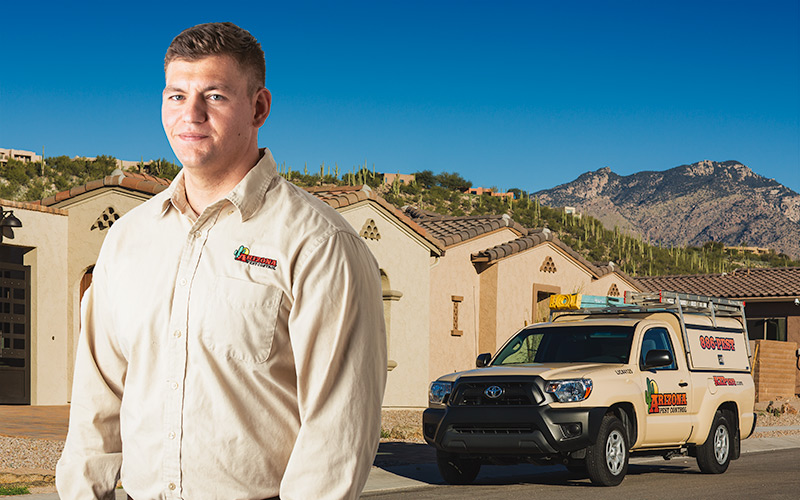Termites are silent and destructive pests that can cause significant damage to your home or property before you even notice their presence. If you live in Tucson, understanding the types of termites that are common in the area is crucial for taking timely preventative measures and avoiding costly repairs.
This blog outlines the most common termite species found in and around Tucson, how to identify them, and tips to protect your property from infestation. By the end of this guide, you’ll better understand the termite challenges unique to Tucson and how to manage them.
Why Tucson Houses Termite Hotspots
Tucson’s warm climate and relatively dry conditions make it an ideal habitat for termites. While Arizona’s desert landscape might seem unwelcoming to termites, many species thrive in the region because of the combination of favorable temperatures, sporadic rainfall, and the presence of wooden structures to feast on.
The high number of wooden homes, fences, and other structures in Tucson creates a recipe for potential infestations. By familiarizing yourself with the specific termite species in your area, you’ll be better prepared to spot the signs of termite activity and combat potential damage.
Common Termite Species in Tucson
1. Subterranean Termites (Heterotermes aureus and Reticulitermes species)
Subterranean termites are among the most destructive termite species not only in Tucson but across the U.S. They are known for their underground colonies, which can house thousands or even millions of termites.
What do they look like?
- Workers are creamy white and resemble ants but without the pronounced waist.
- Soldiers have large, darker heads and mandibles used for defense.
- Swarmers (or alates), which often signal the start of a new colony, are dark brown to black and have long, delicate wings.
Behavior and Habitat
- Subterranean termites create extensive underground colonies and build mud tubes leading up to sources of wood.
- They prefer moist environments and may use clogged gutters or leaky pipes as an entry point to your property.
Signs of Infestation
- Mud tubes running along walls or foundations.
- Hollow-sounding wood or wood that easily crumbles.
- Swarmers near windows or light fixtures.
2. Drywood Termites (Incisitermes minor)
Drywood termites differ from subterranean termites in that they don’t require contact with soil. Instead, they live and establish their colonies directly inside dry wood.
What do they look like?
- Workers are pale white to light brown and smaller than subterranean termites.
- Swarmers have light brown bodies with smoky-colored, translucent wings.
Behavior and Habitat
- These termites typically infest exposed, dry wood such as furniture, rafters, and wooden fences.
- Drywood termites operate in much smaller colonies compared to subterranean termites but can still cause significant damage over time.
Signs of Infestation
- Small piles of wood-colored fecal pellets near infested wood.
- Tiny holes on wooden surfaces, often accompanied by subtle bubbling or peeling paint.
- No mud tubes, as they don’t rely on soil.
3. Desert Dampwood Termites (Paraneotermes simplicicornis)
Desert dampwood termites are less common than the other two species but are still worth mentioning due to their preference for damp wood.
What do they look like?
- Soldiers are cream-colored with large mandibles.
- These termites are generally larger than both subterranean and drywood termites.
Behavior and Habitat
- Unlike their name suggests, they prefer wood with a high moisture content, such as wet logs, tree stumps, or water-damaged wooden structures.
- They do not require soil contact but are highly drawn to soft, damp wood.
Signs of Infestation
- Wood damage near areas of high moisture, such as leaking pipes or a damp foundation.
- Visible termites inside decaying or rotting wood.
How to Protect Your Tucson Property from Termites
Understanding the types of termites you may encounter is only half the battle; prevention and early detection are key to protecting your property from extensive damage.
1. Remove Moisture Sources
Subterranean and desert dampwood termites are attracted to moisture. Ensure that you fix leaky pipes, proper drainage issues, or clogged gutters that can create damp environments.
2. Address Wood-to-Soil Contact
Subterranean termites build mud tubes to move between their nest and food sources. To prevent this, reduce or eliminate contact between wooden structures around your property and the soil.
3. Regular Inspections
Termites can be elusive, so scheduling an annual inspection with a licensed pest control professional can help identify any initial signs of infestation before it escalates.
4. Seal Cracks and Gaps
Seal cracks in your home’s foundation, walls, and around piping to block potential entry points for termites.
5. Use Termite-Resistant Materials
If you’re building or renovating in Tucson, consider using termite-resistant building materials such as cedar, pressure-treated wood, or even metal where possible.
6. Stay Vigilant
Keep an eye out for signs mentioned in this post, such as mud tubes, wood damage, or swarming termites, as these are often the clearest indicators of an infestation.
Partnering with Pest Control Professionals
DIY solutions are a great first step for prevention, but termite infestations often require professional treatment. Experts provide advanced detection, effective eradication, and long-term prevention techniques tailored to the unique challenges of Tucson’s termite population.
If you suspect termite activity or want peace of mind, consider reaching out to a trusted pest control specialist in Tucson to safeguard your home or business from these silent intruders.
Safeguard Your Tucson Property Today
Understanding the termite species around Tucson is valuable in keeping your home or property safe from their destructive impact. Whether it’s the moisture-loving subterranean termites or the stealthy drywood termites, early detection and proactive prevention measures can save time, money, and frustration.
Interested in taking the next step? Speak with a pest control professional today and shield your property against termites before they have a chance to damage your home.











